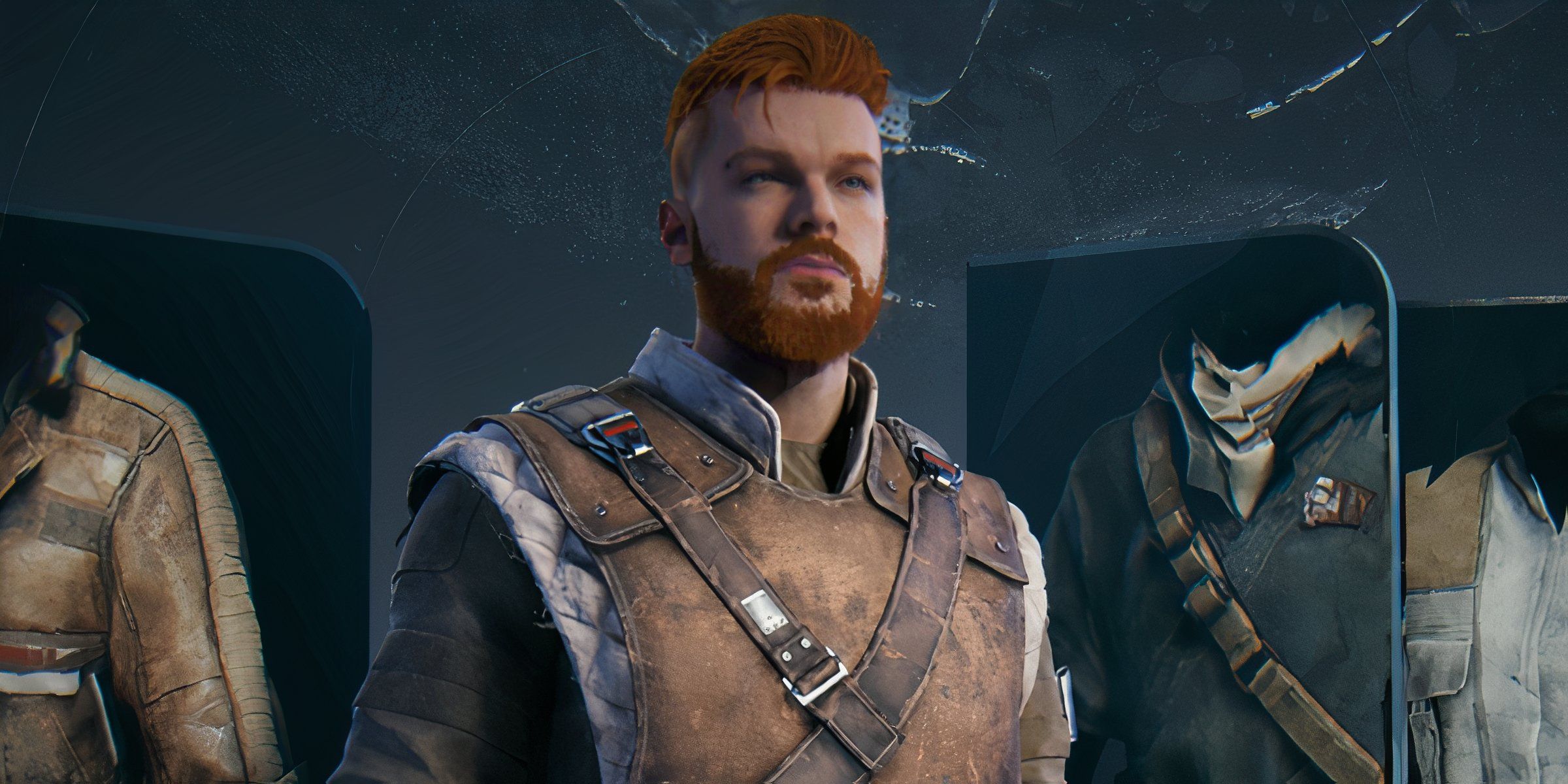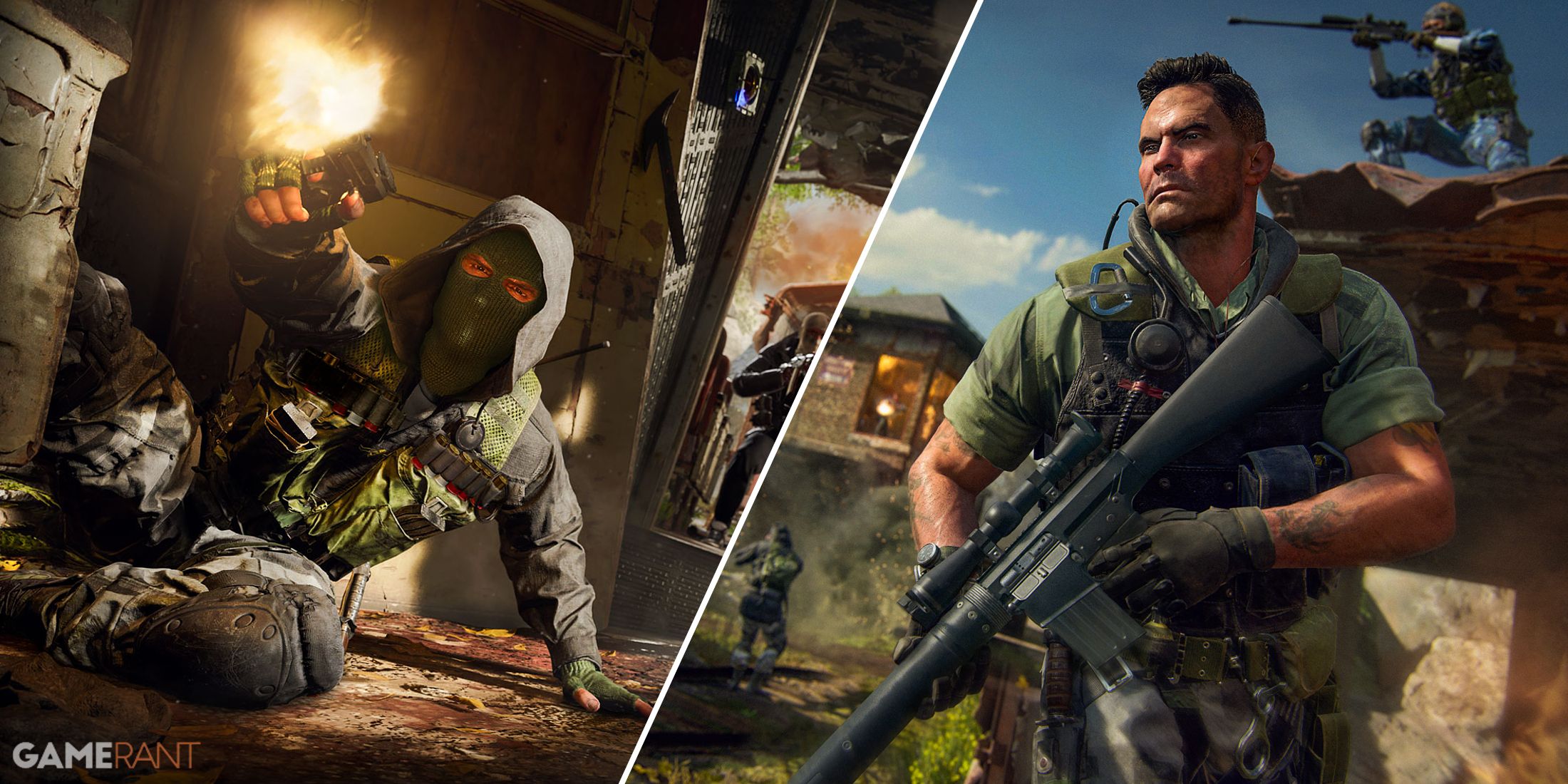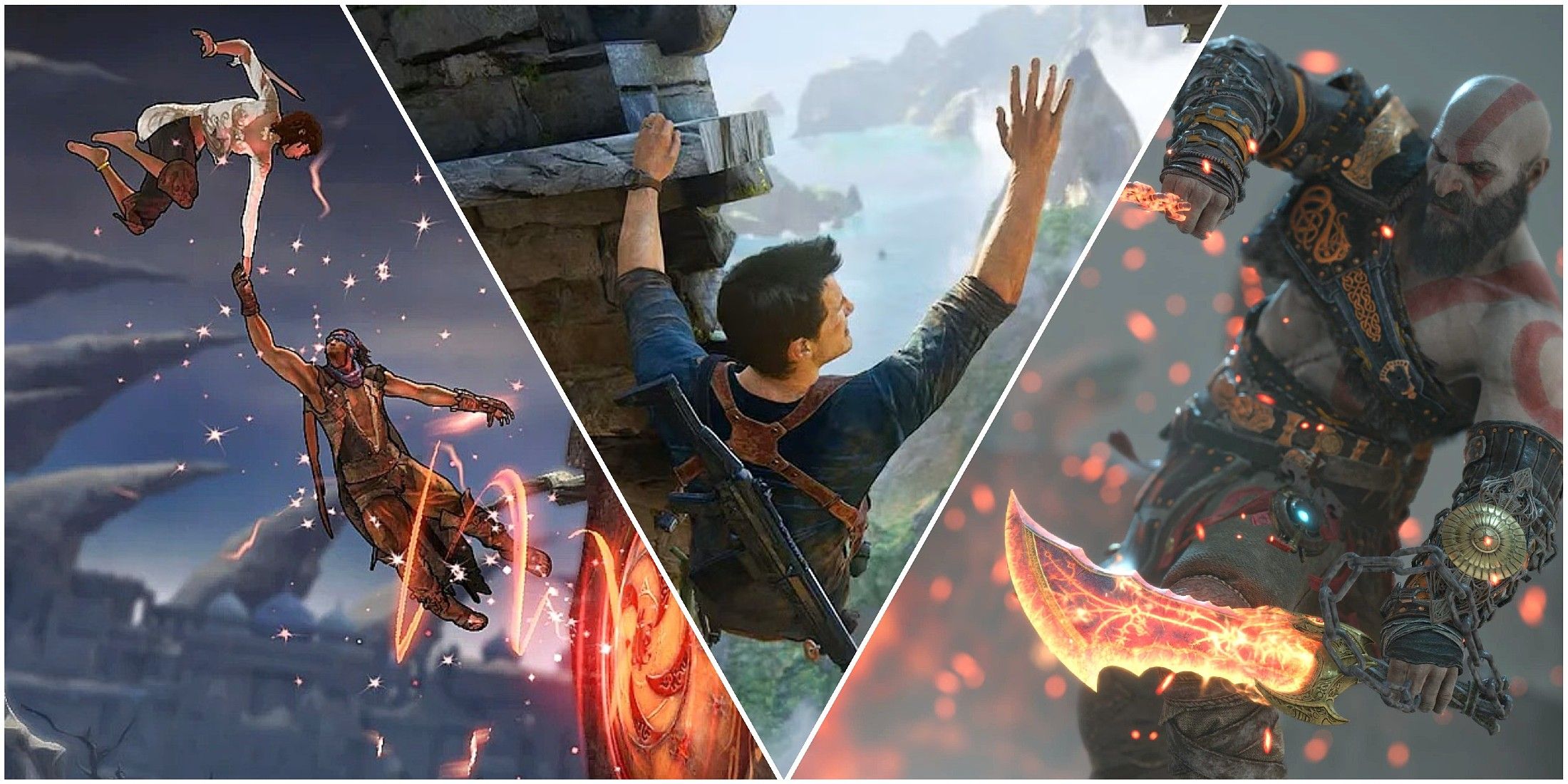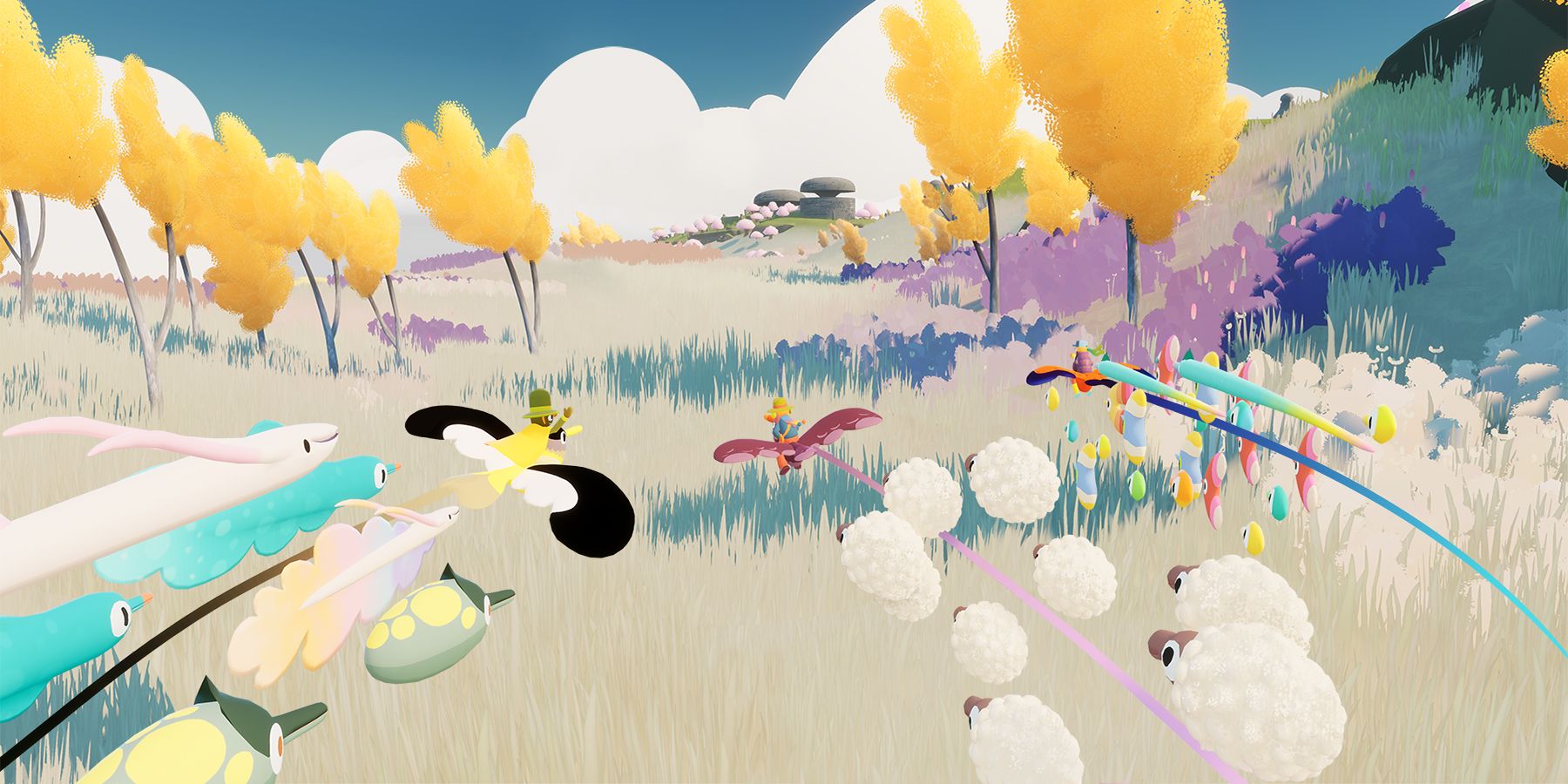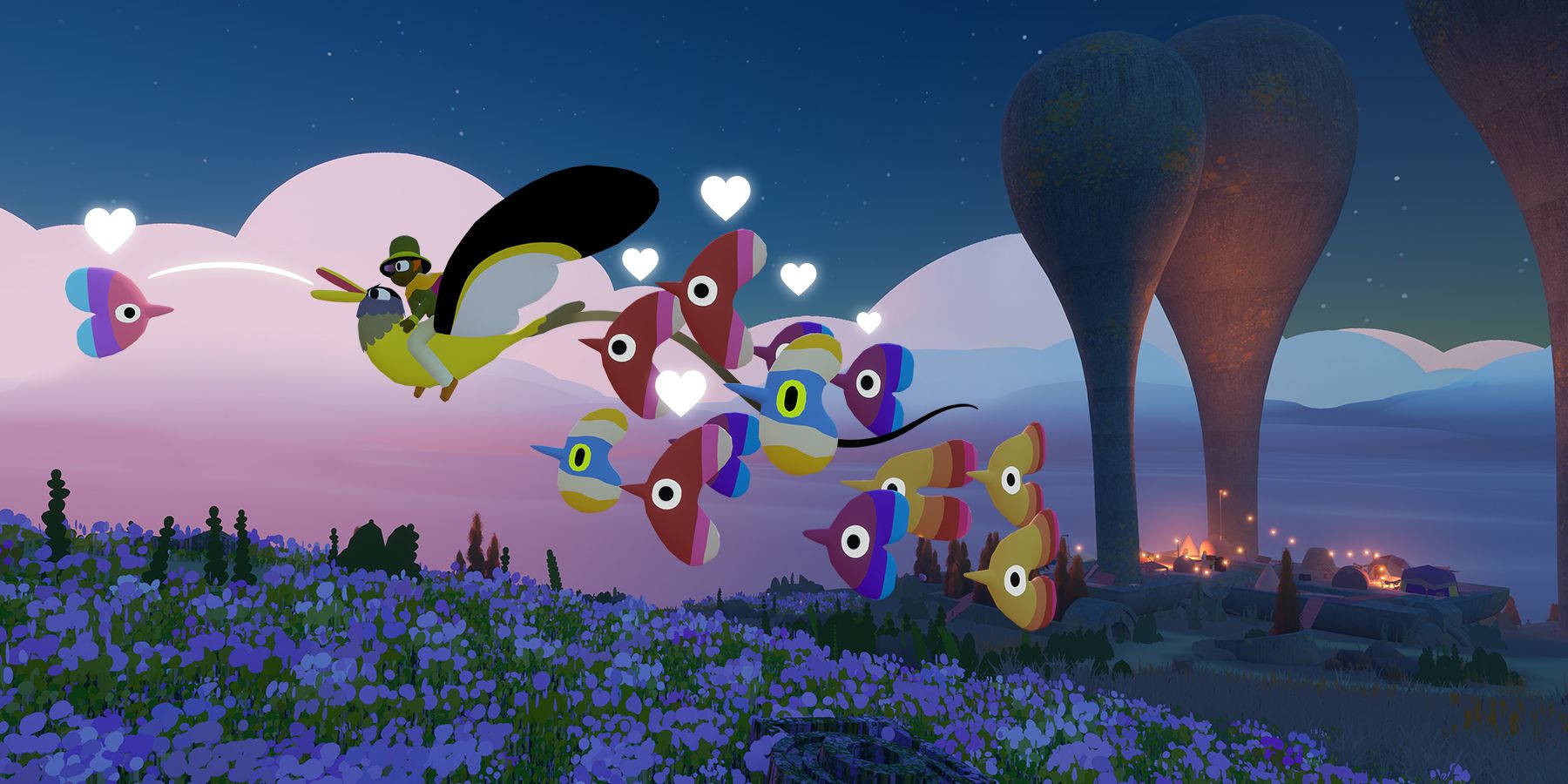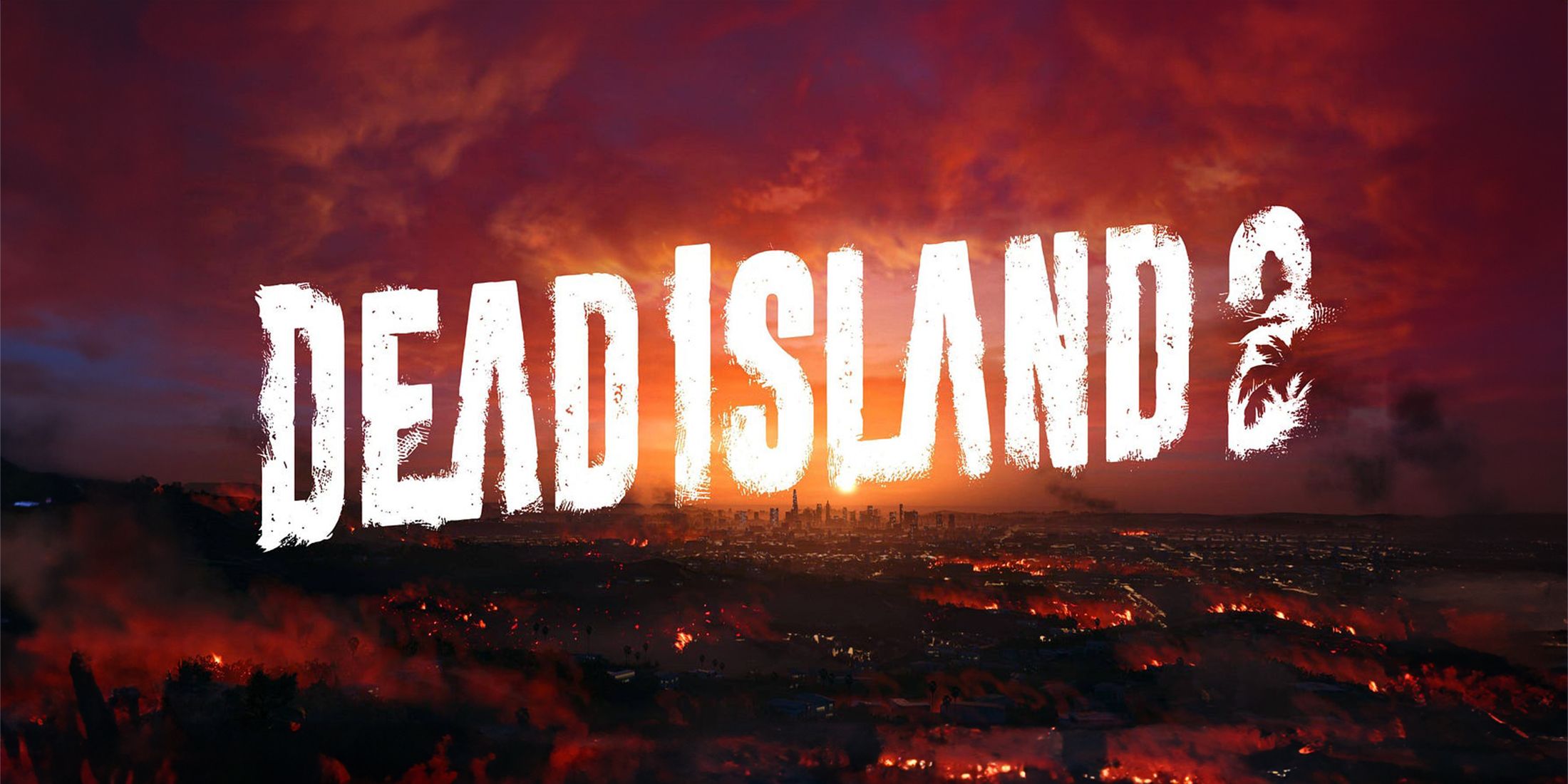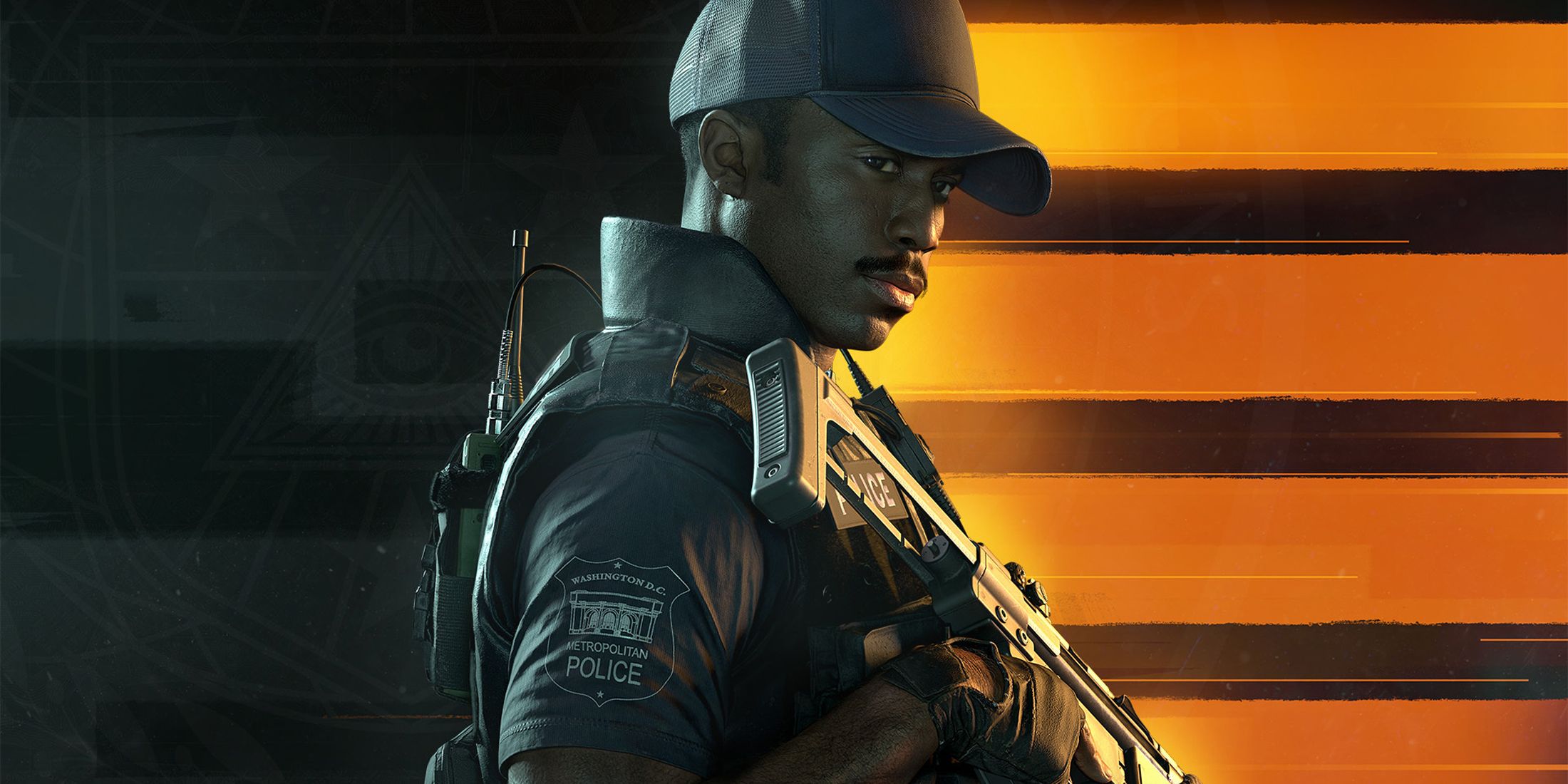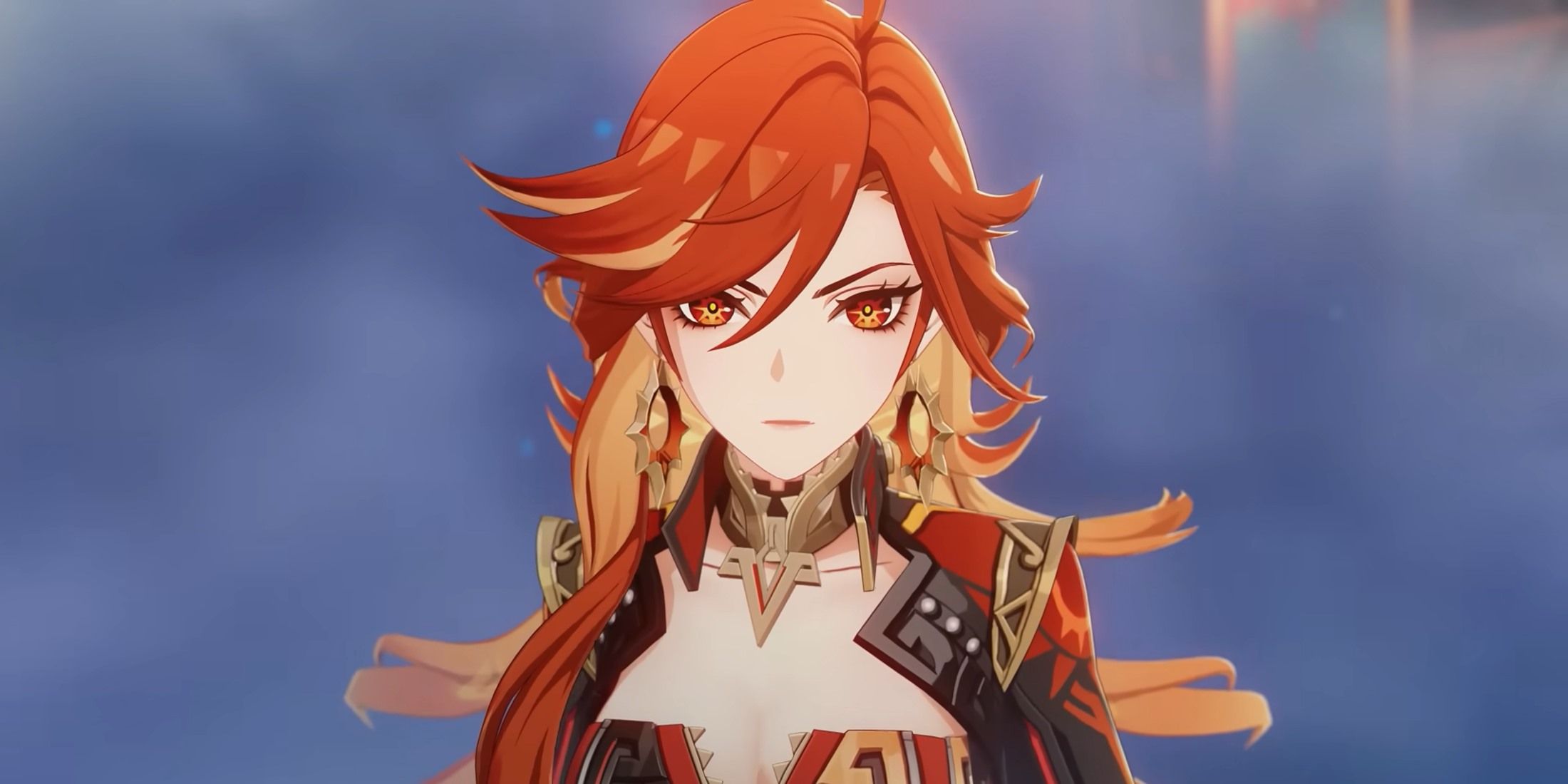Flock is an upcoming title from developer Hollow Ponds that fuses avian flight with non-violent creature collection. The new game is being published courtesy of Annapurna Interactive, a well-known publisher that helps uplift various indie developers. Annapurna and Hollow Ponds recently showed off a gameplay walkthrough of Flock at their digital showcase event, giving prospective players a taste of the game's collaborative and exploratory potential.
Game Rant recently spoke with Richard Hogg and Ricky Haggett, the art and creative directors of Flock about the game's creature collecting mechanics, number of companions, map size, and much more. The following interview has been edited for brevity and clarity.
Q: Please introduce yourselves briefly, and describe Flock for players who have yet to hear about the title.
Richard Hogg: I’m Richard Hogg. I am one of the people who made this game. Ricky and I have been making games collaboratively for over fifteen years. We work with a bunch of other people now. I’ll let Ricky do the bit where he describes what Flock is. Oh, I’m the art guy, mainly.
Ricky Haggett: I’m Ricky Haggett. I am the design director of Hollow Ponds, or the creative director, or something. I do programming, game design, and creative direction. Dick and I kind of share—like, I do a lot of programming and system stuff and Dick does art stuff—and there’s the bit in the middle where we share a lot of design with our team as well. And what is Flock? Flock is a game where you fly around the wilderness on the back of a big bird. You are exploring and looking for wild creatures to add to your flock.
Hogg: So it’s a game about finding all the creatures. It’s a game about accumulating a little squad of creatures that follow you around. It’s a multiplayer game, but it can be enjoyed in single-player as well. It works very well as a single-player experience. You also have sheep—there are creatures that live in the world that are wildlife—and there are sheep you are supposed to be looking after. In terms of vibes, it’s quiet and relaxed.
All the games we make are low-stress, chill sort of things, and Flock is no exception to that. It’s about exploring, just hanging out in this beautiful place, and discovering all the creatures that live there. And maybe hanging out with your friends.
Q: Unlike most creature collectors which rely on combat, Flock features unique mechanics for recruiting new creatures relating to time of day, proximity, and song. What other mechanics can players expect to encounter when building their flocks?
Hogg: Yeah, there’s no combat. The core way you collect creatures we call ‘charming.’ How would you describe it… I really don’t want to call it a fishing mechanic but it is probably not a million miles away from what happens in most fishing games.
Haggett: It’s like a movement minigame, I suppose. The creature moves, you are free to move around as well, and it is sort of like a dance. There’s a sweet spot between not getting too close and not drifting too far away. Finding creatures in the first place is a thing. Some creatures are just there in the world to be flown up to, identified, and charmed, but some of them are hidden. Some of them will try to get away from you, and you have to chase them. Some of them you have to track. There are a bunch of different ways to find creatures in the world.
Hogg: There’s a kind of identification stage that’s also like a minigame, where you have to narrow down what family it is in and guess which creature it is. You’ve got a field guide that you are filling in as you go, so you can identify creatures even if you haven’t managed to charm one into your flock yet.
There are a bunch of mechanics in the game that aren’t related to creatures, but to do with flying around and how you move around the world. A lot of work went into the title—we wanted to make the game feel of flying around was really good. When I play this game, I spend a lot of time just enjoying whizzing around. I don’t know how to describe it.
Haggett: It’s very frictionless. You point your bird in a direction, and it will flow effortlessly around trees and over things. It will ramp up off things. There are thermals to rise up in the air. There are just a bunch of nice ways for moving around the landscape.
Hogg: In the trailer, you might have seen the rings, which you can fly through for a boost, and you chain those to get around the world in a way that is quite kinetic and compelling. It’s addictive.
There are also mechanics related to communication. When you’re playing with other people, you might want to show them something, simply tell them where you are, or find out where they are. Flock happens in a big open world where it is quite easy to get lost, so you need tools to not feel overwhelmed by that. There’s a map, with tools and mechanics to mark locations. You can leave markers for your own benefit or the benefit of friends.
Q: In the showcase, it was mentioned that players could tame sheep and then create clothes out of the sheep’s wool. Are there other creatures with unique avenues for interaction?
Haggett: There are, but none of them are quite like the sheep. There are other wild creatures that do interesting things at certain times or locations.
Hogg: There is one type of creature in the wild that has a particular interaction we aren’t revealing yet, but it’s kind of a key to progress in the game. That’s under wraps at the moment, and there are certain creatures where it’s kind of like a quest to find them.
It’s not a straightforward thing. With most creatures in the world, it’s a case of discovering where they live, what they disguise themselves as, maybe what time of day they are around, and just being patient and observant. There are creatures where you have to follow clues in a more specific way. Like, you complete one part of the quest, and then you’re onto the next part. It’s a more involved series of tasks.
Haggett: In terms of giving the player abilities, your flock is primarily an expression of which sort of creatures you like having. As you gain the ability to have more creatures in your flock, you can get quite particular about what sort of creatures you want to have. There was an earlier version of this game where you had to have very specific sets of creatures to complete tasks, and we’ve steered away from that. It’s more like a costume, or customization.
Hogg: That’s based on watching people play the game. It’s interesting to see people get attached to specific creatures and their personalities. We didn’t want to make it so people had to do without their favorite creatures or worry about their load out. We’ve moved away from that to something more like an extension of choosing what clothes you want to wear.
Q: Can you tell us a little more about the fable Golden Bewl referenced on the game’s Steam listing?
Hogg: Oh! There’s a famous Golden Bewl on the Steam listing! I didn’t know that. That’s really interesting. No, we can’t tell you anything about that. We have to leave that as a mystery. Maybe it’s McGuffin, or maybe it’s the most important thing in the game. [Laughing] I don’t know.
Q: How large is Flock’s overworld? Is the map designed or procedurally generated?
Haggett: It’s completely handmade. It’s a couple of square kilometers, though it’s not a square. It has very dense, complicated bits of it, and it has very open, sparse sections. Exactly how big it is in purely geographical terms isn’t that useful of a measurement. It’s quite an undulating and complicated sort of place, lots of hills and valleys.
Hogg: How many areas are there? Most of the trailer we released is set in a sort of grassland area. Quite a large area in the game like a prairie or a steppe. It’s a large sort of central part of the game. Big with lots of little nooks and crannies, but a generally open feel.
There are other areas in the game that are very much like being in a dense forest. There are some very small, unique habitats you can find, like little pockets.
Haggett: It doesn’t take ages to traverse. You can fly from one end of the map to the other in a couple of minutes because your bird flies very quickly, but obviously, you will miss a lot along the way.
Hogg: It’s interesting, isn’t it? Thinking about it—this was a hard thing to get right—but hopefully, it feels like a big world in the sense that you can find things you’ve not come across, even if you’ve been playing quite a long time. However, it’s not big in the sense of hugeness. If your friend is a long way away from you and they need help doing a thing, and they call out to you, giving you a marker showing where they are, you can make it to them pretty quickly. You know, you’re riding a bird. Birds are pretty good at getting around.
I hope lots of player experiences will be like “wow, I’ve been playing this game for quite a while, and I’ve never seen that before.” I’m making the game, and I still get lost. I had to look at the map. I want to make a game where players can get a bit lost without feeling overwhelmed. It’s not huge in a way…It’s not Red Dead Redemption. Except in that, you can fast travel, and there is no fast travel in our game.
Q: Roughly how many different sorts of creatures can players recruit to their flock?
Hogg: It’s about sixty creatures and they are divided by families. There are about twelve families, but they are not equally divided. Some families have more members than others, like say a crow family versus a duck family.
Q: How many players will Flock support simultaneously?
Haggett: That mostly depends on performance, really, but we haven’t really locked that down yet. I don’t know we can say yet. I think that the upper limit is more than eight, or perhaps even as many as eight might feel like too many. It may derail things and make the experience confusing. It could be chaotic in a way that would fight against the vibe of the game. It’s not a massively multiplayer game. Really, the question is, how many players would want to fly and have a chat together as a group?
Hogg: I think eight would be a nice number. You wouldn’t want to go any higher than that. But whether that’s technically possible, I’m not sure yet. I like to think of at least five. That’s probably the number of people I would want to play with.
Q: Many of Flock’s flying creatures are normally terrestrial or oceanic. What inspired this fish-out-of-water approach to flight?
Hogg: I designed all the creatures in the game, and I knew it was never going to be a game where it’s all birds. I wanted there to be creatures that kind of felt familiar, albeit in a surprising way. Like, there’s a creature that’s kind of like a dolphin, except it’s a weird flying dolphin that buries itself in the ground when it’s sleeping. Then there are creatures that are insect-like, but they’re not insects. I don’t know, I just find that kind of thing fun. Taking inspiration from nature but in a very non-literal way.
We have a creature in the game that really looks like a radish, even though it moves like a tadpole. I enjoy the creative process of thinking about stuff like that, and I hope players find that fun and relatable. I think if they were all crazy alien things, they may be less relatable. There’s a creature that’s quite common in the game that… it’s effectively a chicken. We’ve really leaned into making its personality chicken-like, but there are other creatures in the game that are quite strange as well. Hopefully, the balance is right.
I love nature. I’m a bit of a wildlife person. I enjoy watching nature documentaries and stuff like that, and I incorporated that into designing the game and making it fun to play.
Haggett: It was also fun figuring out what sorts of sounds all these creatures would make. Most likely, you’ll hear creatures before you see them, and they all have these distinctive sounds. It’s interesting to consider what sound an individual creature makes, versus what kind of soundscape a family makes. And similar to Dick’s inspirations across the animal kingdom, the audio is all over the place. The audio is a big mess of insect sounds, monkeys, reptiles, birds—all kinds of stuff, mixed up.
Hogg: Behaviors as well. One thing I really wanted in this game—I really felt passionate about it and I don’t know why—but you know how you get colonies of seals lying around? They look really stupid, derpily lying around. I really wanted to capture that. It’s quite a low-hanging fruit in terms of making it happen because it’s not like they are running around in a pack, but it’s also really funny, and also kind of relatable. Something everybody recognizes from watching David Attenborough.
Q: Is there any story to be discovered in Flock, or is the experience mostly left to self-interpretation?
Haggett: There is a kind of story. Our last game, I Am Dead was mostly story. Complicated narrative. Lots of dialogue and descriptions of things. We knew we didn’t want to make another game like that, but Flock is a game where narratively, you are there doing stuff. You are a shepherd, you have this job to do, finding and cataloging these creatures.
Hogg: There are NPCs you speak to and who tell you things.
Haggett: Yeah, framing that stuff felt necessary. Those characters do have stories and stuff going on with them, but it’s not about that.
Q: What games and other media influenced the development of Flock?
Hogg: We made a game called Hohokum, and the genesis of this game was wanting to make a game with a similar feeling to that. It’s not literally a sequel, but this was intended to be a spiritual successor.
Haggett: Similar sort of vibe rather than mechanically similar. We conceived this game during lockdown, at a time when we didn’t get to see people in real life very much, so we just spent a lot of time playing video games together. Every Sunday, we’d meet up for a couple of hours and play.
Hogg: We did some Roblox stuff, people designing interesting places and exploring them together with friends while having a chat. It’s a multiplayer thing that is not competitive, and gently collaborative. We wanted to make a game that has that kind of feeling.
We played a lot of Valheim around that time, and Valheim obviously does have combat, but it also has that same sense of exploring a big world with your friends, where people can go off and do their own things. I spent a lot of time in Valheim sailing on my own while everybody else was smelting or something. Just chatting and sharing screenshots of something I’ve seen—I think those kinds of experiences are really compelling. During the lockdown, those games were really like a lifeline to me.
Haggett: Does the real world count as other media? The real world was an inspiration. Just taking walks in the world.
Hogg: Yeah, going bird watching. When I was a teenager, I was very interested in birdwatching. Now I’m an adult, and I go through phases of being more interested in it than others. I’m making a list of every bird I’ve seen this year. Which is interesting to do in the context of making this game. Like, what is my motivation? How do I feel after seeing a bird I haven’t seen in a long time? So those experiences are very valuable to me.
Q: Flock features a very vibrant art style with lots of rounded edges and no cell-shaded outlining. How did you develop this aesthetic?
Hogg: [laughing] This game has been a learning curve for me in terms of the art style. My background is making very stylized art in two dimensions. I Am Dead has three-dimensional assets, but the nature of the art style is such that it feels very flat. And for I Am Dead I was able to make concept art that would be very similar to the screenshots in the game. At the time, I had no skills in 3D modeling. I knew nothing about how to work Unreal Engine. So I was doing drawings, and other people on the art team were converting them into assets.
In Flock, we knew we wanted it to be more realistic with more realistic lighting, we really wanted a day and night cycle. We wanted a richer world with a real sense of atmosphere. And that was really a challenge for me because I didn’t have the vocabulary for art directing that stuff. So I had to learn quickly how to do that and work with other people to figure that out.
Another thing that happened during COVID was I taught myself to do 3D modeling, so I could actually make a lot of stuff that is in the game itself, while also improving my ability to draw things that involve time of day and atmosphere. Learning to do more realistic things was really fun. The art style itself definitely evolved over a trial-and-error process. Because I didn’t have the vocabulary to be like “I want it to be exactly like this,” it was very trial-and-error. Trying things, seeing what felt good, and iterating on that.
Haggett: Yeah, you spent ages trying to hand paint what it looks like when the sun was coming through the trees. We only got that by having that tech in Unreal, and looking at it, and saying “Well, that just looks like some generic 3D Unreal stuff. So how do we make that suit the kind of models Dick is making?” And that was just a long process of slowly moving toward it.
Hogg: Three or four other people were involved in this process, and one job title I didn’t even know existed before we made this game was a technical artist. Our amazing technical artist, it kind of boggles my mind, what he does for a living. We’ve had so many great conversations about what we want, and to what extent are things realistic versus stylized. Between us all, we’ve kind of figured it out, and making this last trailer was really rewarding. I’m really happy with how the game looks, but there’s a real learning curve.
Q: Is there anything else you would like our readers to know?
Hogg: We mentioned at the start that you can play this game single-player, right? I have anxiety now that the trailer has done too much of a good job of selling this game as a multiplayer game, and it’s important to me that people know you can play it single-player and have a full experience in single-player.
Haggett: And I think we’re covered!
[End]
Flock is currently in development for PC, PlayStation 4, PlayStation 5, Xbox One, and Xbox Series X|S.


